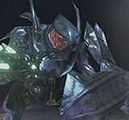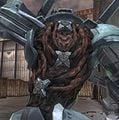Lekgolo: Difference between revisions
From Halopedia, the Halo wiki
m (1 revision) |
No edit summary |
||
| Line 1: | Line 1: | ||
{{Era|Forerunner|Covenant|Human|UNSC|HCW|Post}} | |||
{{Ratings}} | {{Ratings}} | ||
<center>''See also [[Mgalekgolo]] for more information on Lekgolo assemblages.''</center> | <center>''See also [[Mgalekgolo]] for more information on Lekgolo assemblages.''</center> | ||
{{Covenant Species Infobox | {{Covenant Species Infobox | ||
|name=Lekgolo (''Ophis congregatio'') | |name=Lekgolo (''Ophis congregatio'') | ||
| Line 18: | Line 15: | ||
}} | }} | ||
The '''Lekgolo'''<ref>''[[Halo: Ghosts of Onyx]]'', page 190 - "Lekgolo: the Elite name for the Hunter race".</ref> (Latin ''Ophis congregatio'', meaning "Assembly of snakes",<ref name="bestiarum">''[[Bestiarum]]''</ref>) are a species of small colonial worm-like creatures that can join together to form purpose specific assemblages, such as [[Mgalekgolo]], commonly referred to by [[human]]s as Hunters. Lekgolo are also able to combine themselves within machinery such as the [[Type-47 Ultra Heavy Assault Platform|Scarab]] (the ''[[Halo 3]]'' model) and use their combined intelligence to pilot, or control, the vehicle or machinery.<ref>[http://www.bungie.net/News/content.aspx?type=topnews&cid=13160 Bungie Weekly Update 01/11/08].</ref> | The '''Lekgolo'''<ref>''[[Halo: Ghosts of Onyx]]'', page 190 - "Lekgolo: the Elite name for the Hunter race".</ref> (Latin ''Ophis congregatio'', meaning "Assembly of snakes",<ref name="bestiarum">''[[Bestiarum]]''</ref>) are a species of small colonial worm-like creatures that can join together to form purpose specific assemblages, such as [[Mgalekgolo]], commonly referred to by [[human]]s as Hunters. Every worm-like creature is an individual eel, about 1.4 meters long, with its own central nervous system. | ||
Lekgolo are also able to combine themselves within machinery such as the [[Type-47 Ultra Heavy Assault Platform|Scarab]] (the ''[[Halo 3]]'' model) and use their combined intelligence to pilot, or control, the vehicle or machinery.<ref>[http://www.bungie.net/News/content.aspx?type=topnews&cid=13160 Bungie Weekly Update 01/11/08].</ref> | |||
The only times that individual Lekgolo can be seen in the Halo games are in ''Halo 3''. If you shoot at a Hunter's exposed Lekgolo worms, small eel-like creatures will fly out of the corpse, but will disappear after a few seconds. Also, they appear by themselves in the book [[Contact Harvest]] being used to explore the [[Forerunner Dreadnought]]. | The only times that individual Lekgolo can be seen in the Halo games are in ''Halo 3''. If you shoot at a Hunter's exposed Lekgolo worms, small eel-like creatures will fly out of the corpse, but will disappear after a few seconds. Also, they appear by themselves in the book [[Contact Harvest]] being used to explore the [[Forerunner Dreadnought]]. | ||
| Line 29: | Line 26: | ||
Thus, those Lekgolo colonies which preserved Forerunner relics were incorporated into the Covenant, while those that destroyed relics were eradicated.<ref>'''[[Halo Encyclopedia]]''', ''page 114''</ref> This extermination campaign proved to be difficult, as the Lekgolo were able to combine into powerful [[Mgalekgolo]]; consequently, the Lekgolo won most, if not all, ground engagements. The Covenant's forces were completely overwhelmed by the sheer size and ferocity of their foes. On the verge of defeat, the Covenant took desperate measures, threatening to [[Glassing|orbitally bombard]] the planetary surface of Te unless the Mgalekgolo surrendered. | Thus, those Lekgolo colonies which preserved Forerunner relics were incorporated into the Covenant, while those that destroyed relics were eradicated.<ref>'''[[Halo Encyclopedia]]''', ''page 114''</ref> This extermination campaign proved to be difficult, as the Lekgolo were able to combine into powerful [[Mgalekgolo]]; consequently, the Lekgolo won most, if not all, ground engagements. The Covenant's forces were completely overwhelmed by the sheer size and ferocity of their foes. On the verge of defeat, the Covenant took desperate measures, threatening to [[Glassing|orbitally bombard]] the planetary surface of Te unless the Mgalekgolo surrendered. | ||
In [[784 | In [[784 BCE]], the Covenant absorbed the Lekgolo incapable of consuming Forerunner relics into their ranks and eradicated the colonies which had caused harm to the Forerunner relics in orbit.<ref>''Halo Encyclopedia'', page 114</ref> The Mgalekgolo gestalts were later given thick armor plates and [[Assault Cannon]]s to help them serve the Covenant as shock troops. | ||
During the [[Great Schism]], the species was divided between those that supported the [[Covenant Loyalists]] and those that supported the [[Covenant Separatists]] | During the [[Great Schism]], the species was divided between those that supported the [[Covenant Loyalists]] and those that supported the [[Covenant Separatists]]. | ||
== Trivia == | == Trivia == | ||
*"Lekgolo" is [[wikipedia:Tswana language|Tswana]] for "one hundred", probably a reference to their hive-like physiology. | *"Lekgolo" is [[wikipedia:Tswana language|Tswana]] for "one hundred", probably a reference to their hive-like physiology. | ||
*Lekgolo blood is a luminescent orange, and supposedly smells like burnt plastic.<ref>''[[Halo: Ghosts of Onyx]]'', page 221</ref> | *Lekgolo blood is a luminescent orange, and supposedly smells like burnt plastic.<ref>''[[Halo: Ghosts of Onyx]]'', page 221</ref> | ||
*A Lekgolo worm stopped [[032 Mendicant Bias|Mendicant Bias]] from taking off in the [[Forerunner Dreadnought]] by short circuiting the ship's systems. | *A Lekgolo worm stopped [[032 Mendicant Bias|Mendicant Bias]] from taking off in the [[Forerunner Dreadnought]] by short circuiting the ship's systems. | ||
*In ''Halo 3'', Scarabs are controlled by the Lekgolo, proven by the fact that they appear around the reactor of the [[vehicle]]. They also make up the joints of the legs of the Scarab. | *In ''Halo 3'', Scarabs are controlled by the Lekgolo, proven by the fact that they appear around the reactor of the [[vehicle]]. They also make up the joints of the legs of the Scarab. | ||
*The Lekgolo are the most plentiful members of the Covenant, numbering in the trillions. | *The Lekgolo are the most plentiful members of the Covenant, numbering in the trillions. | ||
*When you shoot a Hunter in ''Halo 3'', a Lekgolo worm will fly out of the main colony, wriggle, squirm, and then disappear, as if it is going underground; the Lekgolo probably vanish due to technical reasons in order to avoid framerate problems. | *When you shoot a Hunter in ''Halo 3'', a Lekgolo worm will fly out of the main colony, wriggle, squirm, and then disappear, as if it is going underground; the Lekgolo probably vanish due to technical reasons in order to avoid framerate problems. | ||
| Line 47: | Line 42: | ||
==Gallery== | ==Gallery== | ||
<gallery> | <gallery> | ||
Mgalekgolo_back.jpg|Exposed Lekgolo worms in a Mgalekgolo's back. | File:1203558250 Hunter.jpg|A Hunter, one form of Mgalekgolo, gestalts formed by Lekgolo. | ||
File:Mgalekgolo_back.jpg|Exposed Lekgolo worms in a Mgalekgolo's back. | |||
File:Scarab Lekgolo2.jpg|Lekgolo found in the core of a Scarab. | File:Scarab Lekgolo2.jpg|Lekgolo found in the core of a Scarab. | ||
File:Hunter blood.jpg|Lekgolo blood. Note the luminous properties. | |||
</gallery> | </gallery> | ||
| Line 59: | Line 56: | ||
*[[Assault Cannon]] | *[[Assault Cannon]] | ||
*[[Type-47 Ultra Heavy Assault Platform|Scarab]] | *[[Type-47 Ultra Heavy Assault Platform|Scarab]] | ||
*[[Assembly ( | *[[Assembly (Level)|Assembly]] | ||
{{Covenant}} | {{Covenant}} | ||
[[Category:Covenant Species]] | [[Category:Covenant Species]] | ||
[[Category:Living Organisms]] | |||
Revision as of 08:38, May 21, 2011
Template:Covenant Species Infobox
The Lekgolo[1] (Latin Ophis congregatio, meaning "Assembly of snakes",[2]) are a species of small colonial worm-like creatures that can join together to form purpose specific assemblages, such as Mgalekgolo, commonly referred to by humans as Hunters. Every worm-like creature is an individual eel, about 1.4 meters long, with its own central nervous system.
Lekgolo are also able to combine themselves within machinery such as the Scarab (the Halo 3 model) and use their combined intelligence to pilot, or control, the vehicle or machinery.[3]
The only times that individual Lekgolo can be seen in the Halo games are in Halo 3. If you shoot at a Hunter's exposed Lekgolo worms, small eel-like creatures will fly out of the corpse, but will disappear after a few seconds. Also, they appear by themselves in the book Contact Harvest being used to explore the Forerunner Dreadnought.
History
The Lekgolo evolved on their homeworld of Te and fed by burrowing through the ground of their planet. They first came into contact with the Covenant when the then young alien order landed in search of Forerunner artifacts. They found only the destroyed remains of a Forerunner space station which had once contained many relics, but was now bare due to the actions of the worms, which had broken down and eaten the devices. The San 'Shyuum viewed this as heresy, and declared war on the Lekgolo in what would later be called the Taming of the Lekgolo. Covenant Fleet commanders soon found that indiscriminate destruction would have unacceptable consequences, however: since the Lekgolo lived in the sacred relics that the Elites were trying to preserve, simply annihilating the Lekgolo would have resulted in the destruction of some or all of those relics. The Arbiter that was created during this crisis suggested that they could be tamed and put to better uses as part of the Covenant Hierarchy.
Thus, those Lekgolo colonies which preserved Forerunner relics were incorporated into the Covenant, while those that destroyed relics were eradicated.[4] This extermination campaign proved to be difficult, as the Lekgolo were able to combine into powerful Mgalekgolo; consequently, the Lekgolo won most, if not all, ground engagements. The Covenant's forces were completely overwhelmed by the sheer size and ferocity of their foes. On the verge of defeat, the Covenant took desperate measures, threatening to orbitally bombard the planetary surface of Te unless the Mgalekgolo surrendered.
In 784 BCE, the Covenant absorbed the Lekgolo incapable of consuming Forerunner relics into their ranks and eradicated the colonies which had caused harm to the Forerunner relics in orbit.[5] The Mgalekgolo gestalts were later given thick armor plates and Assault Cannons to help them serve the Covenant as shock troops.
During the Great Schism, the species was divided between those that supported the Covenant Loyalists and those that supported the Covenant Separatists.
Trivia
- "Lekgolo" is Tswana for "one hundred", probably a reference to their hive-like physiology.
- Lekgolo blood is a luminescent orange, and supposedly smells like burnt plastic.[6]
- A Lekgolo worm stopped Mendicant Bias from taking off in the Forerunner Dreadnought by short circuiting the ship's systems.
- In Halo 3, Scarabs are controlled by the Lekgolo, proven by the fact that they appear around the reactor of the vehicle. They also make up the joints of the legs of the Scarab.
- The Lekgolo are the most plentiful members of the Covenant, numbering in the trillions.
- When you shoot a Hunter in Halo 3, a Lekgolo worm will fly out of the main colony, wriggle, squirm, and then disappear, as if it is going underground; the Lekgolo probably vanish due to technical reasons in order to avoid framerate problems.
- It is unknown whether Lekgolo would be eradicated by the Halo Array since a Lekgolo outside a colony can be considered non-sentient.
- On the Halo 3 multiplayer map Assembly, an "aquarium" filled with Lekgolo waiting to be integrated into a Scarab can be seen.
Gallery
- Scarab Lekgolo2.jpg
Lekgolo found in the core of a Scarab.
Sources
- ^ Halo: Ghosts of Onyx, page 190 - "Lekgolo: the Elite name for the Hunter race".
- ^ Bestiarum
- ^ Bungie Weekly Update 01/11/08.
- ^ Halo Encyclopedia, page 114
- ^ Halo Encyclopedia, page 114
- ^ Halo: Ghosts of Onyx, page 221


